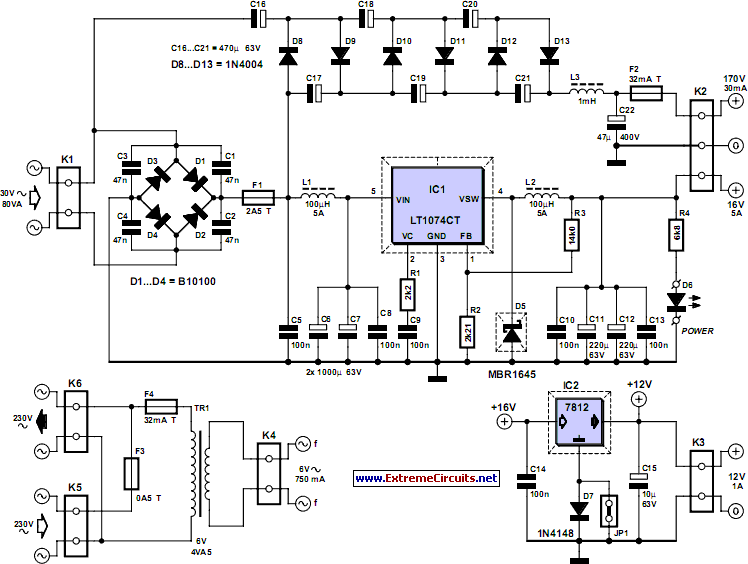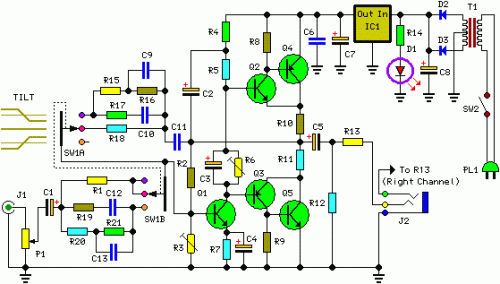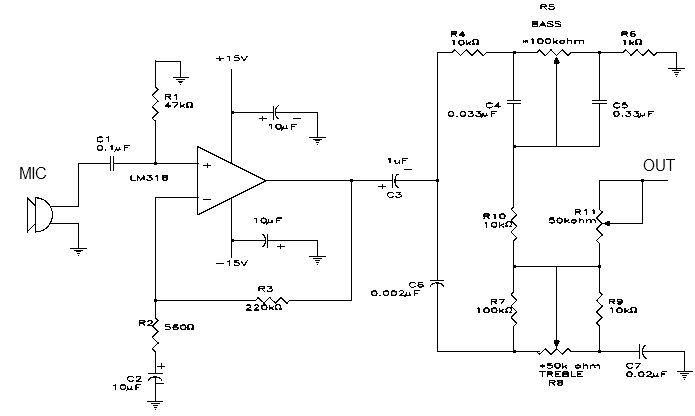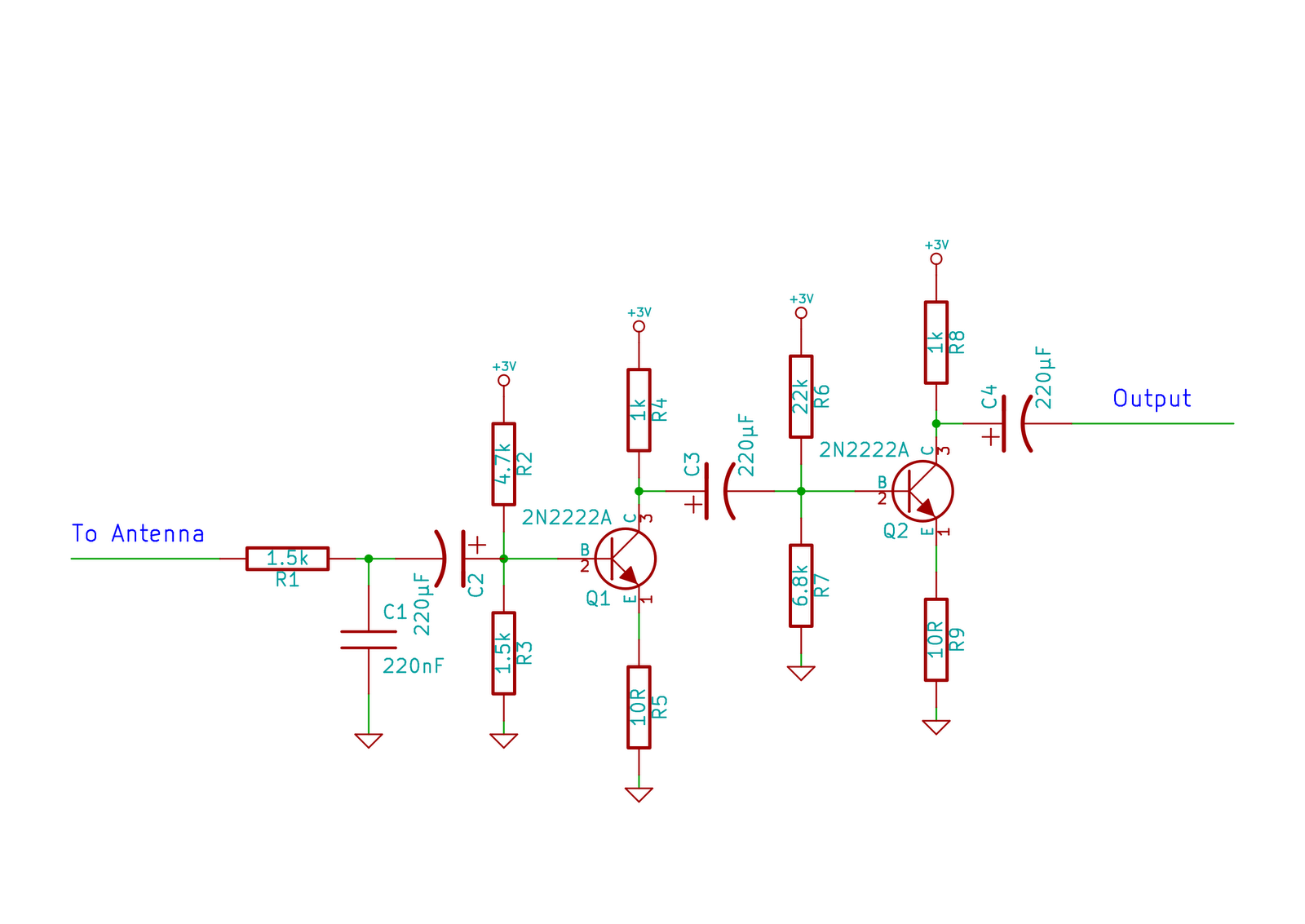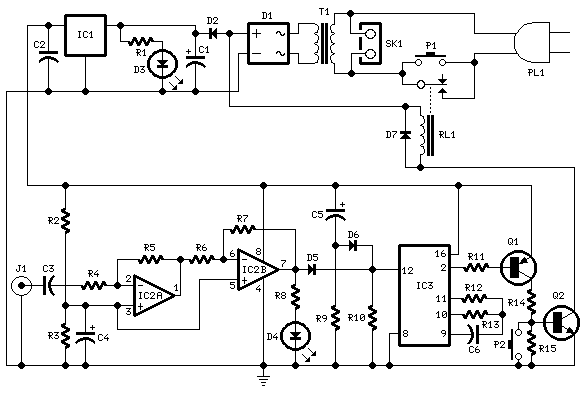
Electric Guitar Matching Amplifier
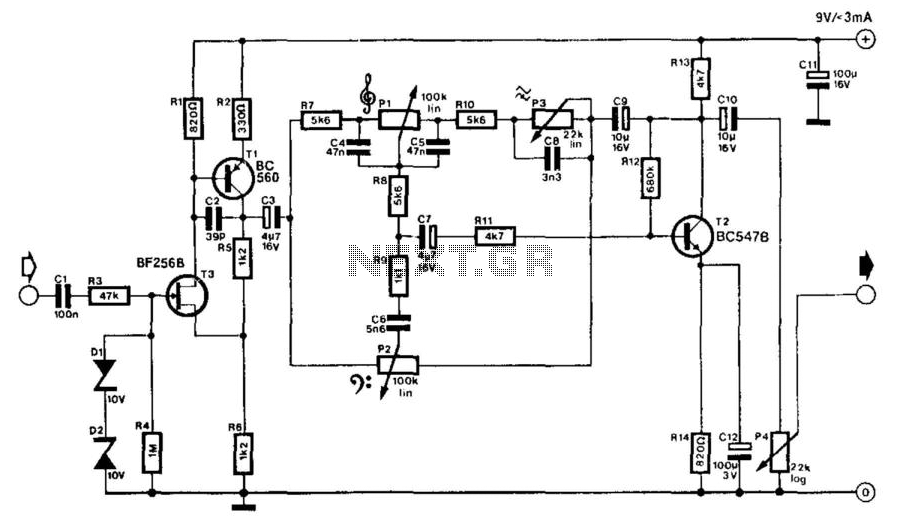
An electric guitar often needs to be connected to a mixing panel, a tape deck, or a portable studio. While cabling is typically not an issue, the challenge lies in matching the high impedance of the guitar pickup to the low impedance of the line input of the mixing panel or tape deck. Even the so-called high impedance inputs of these devices are unsuitable for the guitar output. When the guitar is connected to such an input, very little signal reaches the panel or deck for processing. Although it is possible to connect the guitar to a high impedance microphone input, this input is usually too sensitive for this purpose, leading to frequent clipping of the guitar signal. The matching amplifier described here addresses these challenges: it features a high-impedance (1 MΩ) input that can handle voltages exceeding 200 V. The output impedance is relatively low. The amplifier provides a gain of 2 (6 dB) and includes dual tone control, presence control, and volume control. The circuit can accommodate input levels up to 3 V; beyond this level, distortion increases, which is often desirable in guitar music. Real clipping of the input signal does not occur until significantly higher levels than those produced by a guitar are applied. Power is supplied by a 9-V (PP3) battery, and the circuit draws a current that does not exceed 3 mA.
The described matching amplifier circuit is essential for effectively interfacing electric guitars with various audio equipment, such as mixing panels and tape decks. The high-impedance input is designed to ensure that the guitar's output signal is adequately captured without significant loss. By accommodating voltages over 200 V, the amplifier provides a robust solution that can handle the dynamic range of guitar signals, which may include peaks that exceed typical line-level voltages.
The gain of 2 (6 dB) allows for sufficient amplification of the guitar signal while maintaining fidelity. The inclusion of dual tone control enables users to shape the tonal characteristics of the output, allowing for adjustments to bass and treble frequencies. The presence control further enhances the clarity of the signal, making it suitable for various musical styles.
The output impedance of the amplifier is designed to be low, ensuring compatibility with standard line inputs on audio equipment. This design consideration minimizes the risk of signal degradation when connecting to other devices. The circuit's ability to handle input levels of up to 3 V allows for a wide range of guitar outputs, accommodating both passive and active pickups effectively.
The power supply configuration using a 9-V (PP3) battery ensures portability and ease of use, making the amplifier suitable for live performances and studio settings alike. With a current draw of only 3 mA, the circuit is energy-efficient, allowing for extended use without frequent battery replacements. Overall, this matching amplifier circuit represents a practical solution for musicians seeking to optimize their electric guitar's output for various audio applications. An electric guitar often has to be connected to a mixing panel, a tape deck or a portable studio. As far as cabling is concerned, that is no problem, but matching the high impedance of the guitar element to the low impedance of the line input of the mixing panel or tape deck is a problem. Even the so-called high impedance inputs of those units are not suitable for the guitar output. When the guitar is connected to such an input, hardly any signal is left for the panel or deck to process.
It would be possible to connect the guitar to the (high impedance) microphone input, but it is normally far too sensitive for that purpose; guitar clipping occurs all too readily. The matching amplifier presented here solves those problems: it has a high-impedance (1 ) input that can withstand voltages of over 200 V.
The output impedance is reasonably low. Amplification is 2 (6 dB), Dual tone control, presence control, and volume control are provided. The circuit can handle input levels of up to 3 V. Above that level distortion increases, but that is, of course, a good thing with guitar music. Real clipping of the input signal does not occur until much higher levels than are obtainable from a guitar are applied. Power is supplied by a 9-V (PP3) battery from which the circuit draws a current that does not exceed 3 mA.
🔗 External reference
The described matching amplifier circuit is essential for effectively interfacing electric guitars with various audio equipment, such as mixing panels and tape decks. The high-impedance input is designed to ensure that the guitar's output signal is adequately captured without significant loss. By accommodating voltages over 200 V, the amplifier provides a robust solution that can handle the dynamic range of guitar signals, which may include peaks that exceed typical line-level voltages.
The gain of 2 (6 dB) allows for sufficient amplification of the guitar signal while maintaining fidelity. The inclusion of dual tone control enables users to shape the tonal characteristics of the output, allowing for adjustments to bass and treble frequencies. The presence control further enhances the clarity of the signal, making it suitable for various musical styles.
The output impedance of the amplifier is designed to be low, ensuring compatibility with standard line inputs on audio equipment. This design consideration minimizes the risk of signal degradation when connecting to other devices. The circuit's ability to handle input levels of up to 3 V allows for a wide range of guitar outputs, accommodating both passive and active pickups effectively.
The power supply configuration using a 9-V (PP3) battery ensures portability and ease of use, making the amplifier suitable for live performances and studio settings alike. With a current draw of only 3 mA, the circuit is energy-efficient, allowing for extended use without frequent battery replacements. Overall, this matching amplifier circuit represents a practical solution for musicians seeking to optimize their electric guitar's output for various audio applications. An electric guitar often has to be connected to a mixing panel, a tape deck or a portable studio. As far as cabling is concerned, that is no problem, but matching the high impedance of the guitar element to the low impedance of the line input of the mixing panel or tape deck is a problem. Even the so-called high impedance inputs of those units are not suitable for the guitar output. When the guitar is connected to such an input, hardly any signal is left for the panel or deck to process.
It would be possible to connect the guitar to the (high impedance) microphone input, but it is normally far too sensitive for that purpose; guitar clipping occurs all too readily. The matching amplifier presented here solves those problems: it has a high-impedance (1 ) input that can withstand voltages of over 200 V.
The output impedance is reasonably low. Amplification is 2 (6 dB), Dual tone control, presence control, and volume control are provided. The circuit can handle input levels of up to 3 V. Above that level distortion increases, but that is, of course, a good thing with guitar music. Real clipping of the input signal does not occur until much higher levels than are obtainable from a guitar are applied. Power is supplied by a 9-V (PP3) battery from which the circuit draws a current that does not exceed 3 mA.
🔗 External reference
